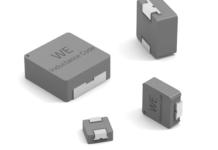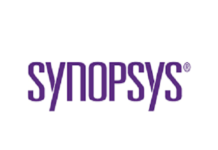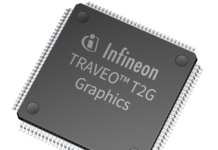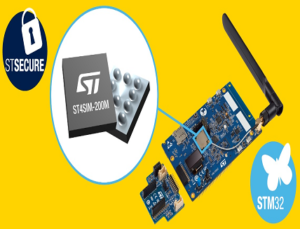
ST recently launched ST4SIM, our first GSMA-certified eSIM for industrial and consumer IoT as well as for automotive. We decided to release the device to offer a more flexible way for engineers to use cellular networks. The eSIM revolution continues to foster the growth of cellular applications by freeing developers. Indeed, instead of being bound to one operator, an eSIM can easily switch to a different network provider. The launch of the new ST4SIM family comes with several models. Some have a basic configuration (ST4SIM-100x), while others are GSMA certified (ST4SIM-200x), have cryptographic capabilities (ST4SIM-x10), or even an automotive certification (ST4SIM-xxxA). A 5G version is even on the way. Let us, therefore, explore ST’s latest eSIM, its first module, its first board, and see how they solve challenges to make cellular networks more accessible to IoT engineers.
ST4SIM and Design Challenges
The Device or Efficiency Solutions
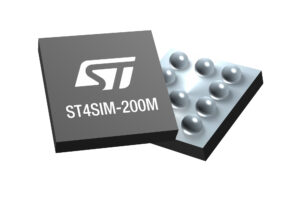
ST4SIM is compliant with GSMA M2M as well as SIMalliance specifications, and it supports 4G (LTE), CAT-M, and NB-IoT, among others. As a result, engineers know that the new ST4SIM is compatible with nearly all networks and operators worldwide. Additionally, the new eSIM is available in WLCSP and MFF2, among other packages. The tiny footprint and cost-effectiveness in high volume of the wafer-level chip-scale package makes it a favorite in industrial applications. On the other hand, the MFF2 is a very standard package that will attract engineers already working on cellular applications.
One of the reasons that pushed ST to enter the eSIM arena was to help engineers create more efficient applications. Design teams sometimes struggle to optimize the performance and power consumption of their cellular connection. Moreover, as IoT products often rely on small batteries, poor optimizations have a snowball effect, especially when some products must last ten years in the field on a single battery. One way ST4SIM solves this issue is by offering an ISO/IEC 7816 protocol between the eSIM and the modem. As a result, when the latter goes to sleep (power saving mode (PSM) or extended discontinuous reception in idle mode (i-eDRX), it can switch off the eSIM for greater energy efficiency. Similarly, ST4SIM also has an SPI interface to enable the microcontroller to communicate more efficiently with its secure element.
The Module or Integration Solutions
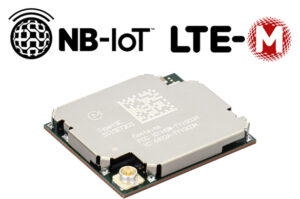
To make the new eSIM even more accessible, Murata is launching the LBAD0ZZ1SE module that includes an ST4SIM-200M, an STM32L462, and an LTE Cat M1/NB-IoT cellular modem. The component solves many design challenges and offers a powerful enough microcontroller to tackle most IoT applications. As a result, it is possible to create a solution that doesn’t require an additional MCU. The module even includes an additional 1 MB of Flash on top of the STM32L4’s 512 KB of Flash and 160 KB of RAM, which will be sufficient to process data from sensors and send them to the cloud, while The MCU’s power consumption of only 2 µA in STOP mode will ensure long battery life.
The module received a GCF/PTCRB certification, which signifies that it integrates all components necessary, including the antenna connector and power regulators (LDO). Hence, teams just need to connect the antenna to the µFl connector and to a battery capable of delivering 3.3 V. Configuration is, therefore, straightforward, bypassing a lot of the inherent complexities associated with eSIM. Developers can simply use the STM32’s bus interfaces (SPI, UART, or I2C) to take advantage of the module rapidly.
ST4SIM and Implementation Challenges
B-L462E-CELL1 or the Hardware Solutions
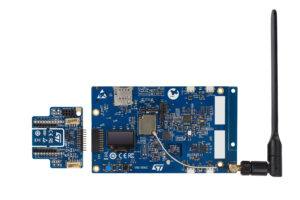
The B-L462E-CELL1, which comes as an alternative to the P-L496G-CELL02 launched in 2018, serves as the fastest way to experiment with Murata’s module and as a reference design to create a new product rapidly. Indeed, engineers can study ST’s schematics as they work on their PCB and use the board to start their application. For instance, it only uses the STM32L4 in the module to help designers size their needs against one of the most popular MCU for this sort of use case. There’s also a slot for teams to use their operator’s plastic SIM card. The B-L462E-CELL1 will automatically detect and use it for greater convenience. Similarly, we included a 0.96-inch OLED display to enable applications to show certain information, such as the operator’s name, the signal’s strength (RSSI), or the time and date received from the Interne
The presence of a low-power audio CODEC on the B-L462E-CELL1 may surprise some. ST decided to add it, along with a 3.5 mm jack for headsets, because the module does provide some VoIP features. However, developers must contact Murata to unlock them. The Discovery Kit also includes an STMod+ port to connect other expansion boards more easily and facilitate prototyping. We also included a myriad of sensors to allow teams to develop an application that can remotely monitor environmental conditions. Finally, users can power the board through its USB port or three AAA batteries. As a result, it is possible to use the board in the field more easily. Moreover, the system can automatically detect where the power is coming from without moving jumpers.
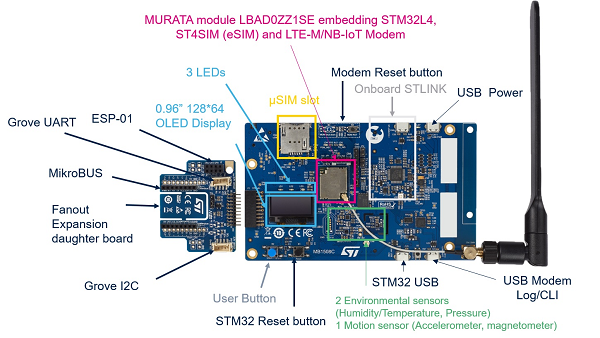
Truphone or the Cellular Plan Solution
Once engineers get their hands on the B-L462E-CELL1, they can immediately enjoy their cellular connection thanks to ST Authorized Partner Truphone. The mobile virtual network operator offers 50 MB of data and some texting capabilities for free for 90 days. The box containing the B-L462E-CELL1 will include instructions on how to register and activate the data plan using Truphone’s web portal. We added the video below to show how to obtain the eSIM’s ICCID from a serial terminal before the activation process. The module’s LTE Cat M/NB-IoT modem also means that it’ll be possible to use the best technology available
Readers can check Truphone’s coverage page to see what cellular protocols are available in their country. Additionally, ST is also working with additional providers. Truphone’s Connectivity Platforms enables users to download and enable profiles from mobile operators as defined by GSMA. As a result, engineers should expect strong support worldwide and, in many instances, automatic recognition of their operator. Moreover, customers wishing to verify Remote SIM Provisioning services can contact Truphone or ST support teams for more information.
X-CUBE-CELLULAR or the Software Solutions
Another critical aspect of ST’s development ecosystem is the X-CUBE-CELLULAR software expansion package. One of its strengths comes from its abstraction layer that enables engineers to switch to different modems by mostly recompiling with the target modem driver provided by ST. X-CUBE-CELLULAR also supports an abstraction layer of communication with ST4SIM. Developers just need to use the ISO interface via the modem or direct communication over SPI. As is traditional, the X-CUBE-CELLULAR offers application examples. For instance, developers can use ST’s software to send a ping command or TCP and UDP echo messages to evaluate the quality of an end-to-end communication over the Internet by checking the latency. Moreover, a Wiki on X-CUBE-CELLULAR will walk developers through how-to’s, tips, and the most frequently asked questions. Indeed the package offers extensive features aimed at greatly facilitating the development of applications.
The X-CUBE-CELLULAR’s middleware manages the configuration of the cellular connectivity and maintains the service’s availability. For example, it selects the right SIM based on policies defined by the end-user and configures the APN accordingly. X-CUBE-CELLULAR will then instruct the modem to connect to the cellular network and will monitor all network status events. It will even inform the application of the cellular service’s readiness for data connectivity to avoid network status polling. Customers can also use the middleware to leverage the ST4SIM secure element to store sensitive information. Handling certificates and keys for secure setup and encrypted communications over the Internet (TLS or DTLS) just became simpler. The software package also supports remote SIM switching using the eSIM Remote SIM Provisioning platform from Truphone. The X-CUBE-CELLULAR package simply monitors SIM switching events to reconfigure the system and reconnect it to the network.
A New Way to Work on Cellular Applications
Too many teams often underestimate the complexity behind the development of cellular solutions. Traditionally, engineers need to learn the AT commands for each modem vendor and write applications around them. Developers must also adopt strict defensive programming paradigms to ensure their system’s robustness regardless of issues that may arise. For example, in the event of a loss of network, the code may need to poll the network status to re-establish the connection. The X-CUBE-CELLULAR middleware does all this on behalf of the application and provides enables developers to handle cellular connectivity as they would with a simple IP protocol.
The package even supports a standard interface based on the popular BSD socket to make things even more intuitive. It also makes it easier to integrate third-party solutions. As a result, ST is working with members of the Partner Program that pre-integrated their cloud middleware, such as LwM2M, on top of X-CUBE-CELLULAR.
For more information, kindly visit ST Blog.



